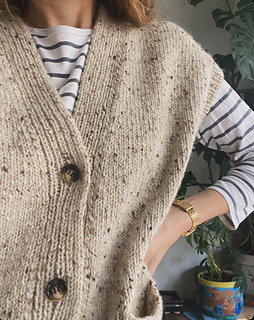patterns >  Trust the Mojo
Trust the Mojo
> Voltaire vest








Voltaire vest
The Voltaire vest is knitted from the top down, in flat knitting without seams. You’ll start by knitting the back with 4.5 mm needles, working back and forth, making increases at the beginning and end of each row to form the dropped shoulders. The back is knitted until the bottom of the armholes, then the stitches are placed on hold to knit the front pieces.
Next, stitches are picked up along the increase rows of the back yoke, and the right shoulder and right front are knitted separately, followed by the left shoulder and left front, with increases that form the V-neckline. Once the shoulders and front pieces are knitted, the left shoulder, back, and right shoulder are joined to knit the lower body, finished with a 3x3 ribbing border using 4 mm needles and a classic bind-off.
The armhole rib edges are knitted in the round with 4 mm needles in 1x1 ribbing, and a tubular Italian bind-off.
The applied button band is also knitted in 1x1 ribbing with 4.5 mm needles.
Finally, the patch pockets are knitted directly onto the work without seams, using 4.5 mm circular needles or double-pointed needles. The pocket edges are finished in 2x2 ribbing, with a variation of the Italian bind-off.
Level and Pattern Content
The Voltaire vest is accessible but involves some technical finishing techniques requiring a bit of experience. The pattern provides detailed written instructions, along with links to video tutorials for more advanced techniques.
Fit and Sizes
The sizes XS (S) M (L) XL (2XL) 3XL (4XL) correspond to a chest circumference of approximately 80/85 (85/90) 90/95 (95/108) 108/120 (120/130) 130/140 (140/150) cm, with a positive ease of about 20 to 25 cm, depending on the size. To choose your size, measure your chest circumference and select the version that suits your desired fit. Try the garment as you knit it to adjust for your preferences and body shape.
Gauge
Before starting, knit a gauge swatch in stockinette stitch to check that your tension is 17 stitches x 24 rows for a 10 cm square. If the measurements do not match, adjust your needle size: use smaller or larger needles until you achieve the correct tension (if you get more stitches for 10 cm, use larger needles; if you get fewer stitches, use smaller needles).
1215 projects
stashed
612 times
- First published: December 2024
- Page created: January 31, 2025
- Last updated: February 7, 2025 …
- visits in the last 24 hours
- visitors right now




